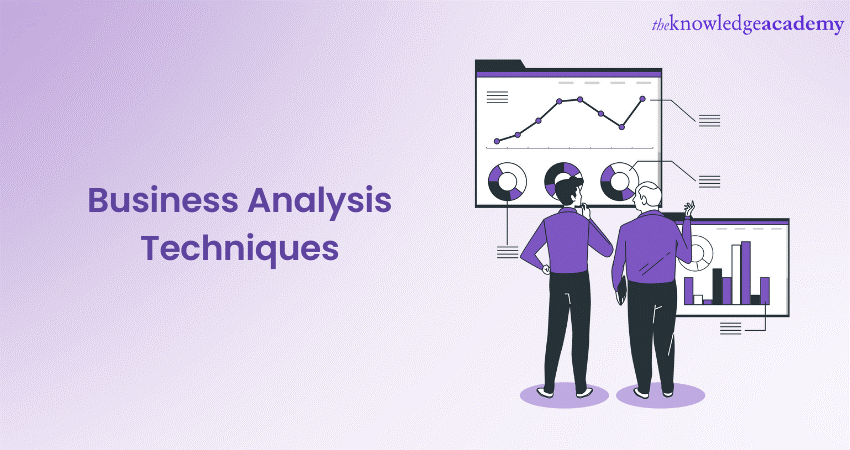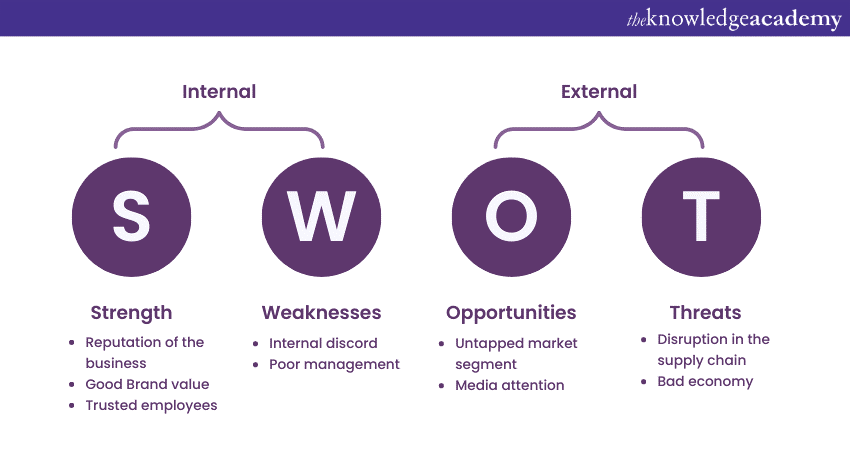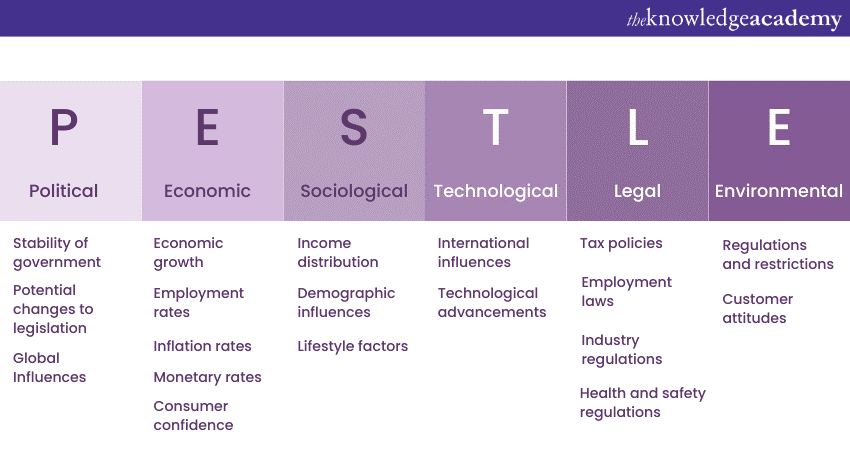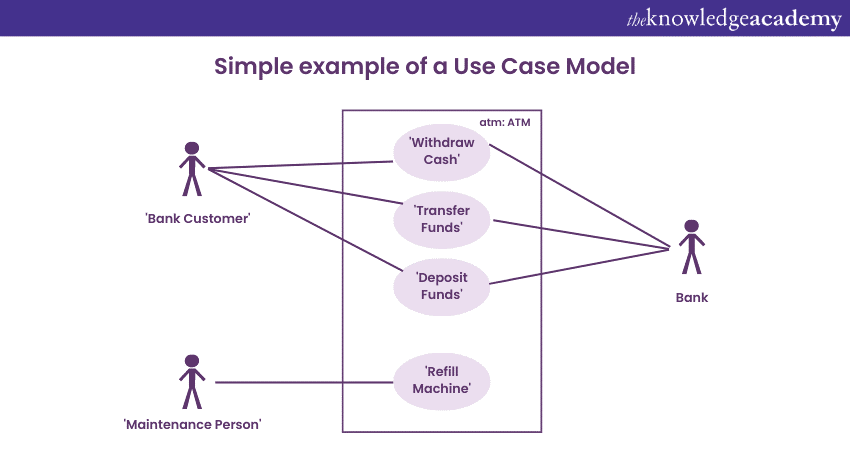We may not have the course you’re looking for. If you enquire or give us a call on 01344203999 and speak to our training experts, we may still be able to help with your training requirements.
Training Outcomes Within Your Budget!
We ensure quality, budget-alignment, and timely delivery by our expert instructors.

Business Analysis is a discipline that assists businesses in identifying problems, assessing possible solutions, and optimising business operations. Business Analysts must be well-versed in several techniques and strategies that help analyse problems and present solutions to the business.
According to a report by the Project Management Institute, such professionals in large organisations spend 83% of their time working and applying Business Analysis Techniques like SWOT Analysis to their projects and programs.
SWOT Analysis is a popular Business Analysis Technique used in Information Technology (IT) businesses and enterprises. SWOT is an acronym for Strength, Weakness, Opportunities and Threats.
Table of Contents
1) What is Business Analysis Techniques?
2) Why is Business Analysis essential?
3) Steps included in Business Analysis
4) Top 12 Business Analysis Techniques
a) SWOT Analysis
b) MOST Analysis
c) Business Process Modelling (BPM)
d) PESTLE Analysis
e) CATWOE
f) Brainstorming
g) MoSCoW
h) Use case modelling
i) The 5 whys
j) Six thinking hats
k) Mind mapping
l) Requirement analysis
m) Non-functional Requirements Analysis
5) Conclusion
What is Business Analysis Techniques?
Business Analysis Techniques are structured processes that can help find an organisation’s requirements and achieve optimal results. This systematic approach involves evaluating data, identifying key performance indicators, and employing various tools to ensure that the Business Analysis is thorough and aligned with organisational objectives.They help find opportunities for improvement, reduce costs and propose effective and innovative solutions. It involves the following processes to achieve that:
1) Performing market research
2) Gathering and analysing data
3) Examining existing processes
4) Exploring potential solutions for complex challenges
Overall, Business Analysis Techniques provide a methodical approach to solving the complex problems of a modern business. They help improve your decision-making and foster continuous improvement.
Why is Business Analysis essential?
For a business to improve and grow, it first needs to identify its areas of weakness and weigh out possible solutions to strengthen them. That is exactly where Business Analysis comes in handy. It helps with your decision-making process on what needs to be changed to optimise the performance of your business operations. Let’s explore the importance of Business Analysis:
1) It helps business find their needs by properly examining the market trends and user feedback and provides methods for aligning their needs with their overall objectives.
2) It can significantly improve and optimise processes using various techniques like gap analysis and process mapping and helps improve the overall efficiency of business operations.
3) Most importantly, it helps businesses reduce risks by predicting potential threats and challenges with the help of data analysis and offers strategies for mitigating them.
Steps included in Business Analysis
From strategic planning to implementing the solutions, Business Analysis encompass several steps. Effective implementation of these steps can help greatly improve the performance of your business. Let’s explore these steps:
1) Strategic planning: Strategic planning is the very first and the paramount step in Business Analysis. It involves planning all the processes to improve your business efficiency.
2) Identifying objectives of the business: This step is crucial for understanding your goals and identifying the specific problems you want to fix and improve.
3) Gather requirements: This step involves gathering the relevant data for defining the solution that aligns with your business goals.
4) Finding effective solutions: Develop potential solutions for fixing the identified problems as well as improving your processes using the gathered data.
5) Implementing the solution: Implement the right solution that meets your business objectives and fixes all the issues.
Get ready for your interview with our top business analyst interview questions.
Top 12 Business Analysis Techniques
Business Analysis Techniques are structured processes that implement and create plans necessary to deliver the best results. There are a lot of techniques, but depending on the business, the techniques used will change.
Here are the top 12 Business Analysis Techniques widely used by businesses.
1) SWOT analysis

The SWOT Analysis is one of the most popular Business Analysis Techniques. It considers internal aspects like strengths and weaknesses and external aspects like opportunities and threats. It is widely used because it is easy to use and not limited to just business. It can be used in any stage of the business or planning.
It is a four-quadrant analysis where each aspect of the analysis
a) Strength: Characteristics of business that give an advantage or edge over competitors. Examples: the business's reputation, brand value, trusted employees, etc.
b) Weakness: Characteristics of business that might put it behind competitors. Example: Internal discord, poor management.
c) Opportunities: The business can take advantage of any external factors or situations. Example: Untapped market segment, media attention, etc.
d) Threats: Any external factor that can create problems for the business or obstruct a project. Or its success and growth. Disruption in the supply chain, bad economy, etc are some of the examples.
Dive into the Detailed Case Study of Business Analysis
2) MOST analysis
The MOST Analysis determines what the business does, their goal, and how they plan to achieve it. This is useful in understanding the business' ability and purpose. MOST stands for Mission, Objectives, Strategy and Tactics.
a) Mission: This is a critical aspect of any business which defines the purpose of the business. It also defines the goal of the business it hopes to achieve. To analyse the next factors, it is essential to be specific about the mission. It must reflect the business' zeal to succeed. If the mission is successful or found to be ineffective, this must be reevaluated.
b) Objectives: This defines each business unit's goals to complete the business' mission. The objectives must be Specific, Measurable, Achievable, Realistic, and Timely (SMART). The company should have clearly defined goals. Pursuing vague objectives is almost impossible and could end up costing the company and hamper its growth.
c) Strategy: This details the steps that a business must take to achieve the set objectives. Any number of strategies can be applied if it helps achieve the targets. If the employed strategy is not working as expected, it is necessary to reconsider it immediately.
d) Tactics: These are discrete and specific methods that form an overarching strategy. Tactics must be easy to execute with clear instructions for the people involved.
In MOST analysis, the mission is an essential factor for the rest of the features. Objectives help achieve the mission, the strategy helps complete the objectives, and tactics help the strategy succeed. When put together, a business can succeed in reaching its mission and its goal.
Want to strengthen your understanding of Business Analysis Techniques and their practical applications? BCS Certificate In Business Analysis Practice Course is the best way to do that.
3) Business Process Modelling (BPM)
Business Process Modelling (BPM) is a technique for visualising and Business Process Analysis to increase efficiency and effectiveness. It entails defining the major steps, inputs, outputs, and stakeholders involved in a process and then visualising the complete process flow.
It often begins with defining the process scope and objectives and then identifying its primary activities and tasks. This data generates a process flow diagram depicting the process's sequence of phases, decision points, and feedback loops.
Organisations can use business process modelling to discover bottlenecks and inefficiencies and look for areas of improvement in their operations. It can also help to improve communication and collaboration among the various departments or stakeholders participating in the process. It also lays the foundation for process automation and optimisation, resulting in cost savings and greater productivity.
Business Process Modelling is a great Business Analysis Technique for businesses that want to improve their operations and achieve more efficiency and effectiveness.
Explore the Key Roles and Responsibilities of a Business Analyst Today!
4) PESTLE analysis

The PESTLE analysis is a Business Analysis framework for identifying and analysing external factors that may impact a business. PESTLE stands for Political, Economic, Sociological, Technological, Legal, and Environmental considerations.
a) Political variables are government regulations and policies that may impact business.
b) Economic factors refer to inflation rates, interest rates, energy costs and labour costs that may directly affect the business' financials.
c) Sociological elements consider cultural and social trends that may impact business.
d) Technological variables refer to the technological advancements, IT and communication that may affect the business.
e) Legal aspects are the laws and regulations that a business must follow.
f) Environmental variables consider the natural environment's impact on the business.
A business can discover prospective opportunities and challenges and change its strategy by analysing each of these elements. PESTLE analysis is crucial for companies to be aware of external factors affecting their operations and make informed decisions to remain competitive in the market.
Check out our guide on Business Impact Analysis to learn how you can keep your critical functions running smoothly.
5) CATWOE
It is a technique for problem-solving and decision-making. It stands for Customers, Actors, Transformation process, Worldview, Owners, and Environmental constraints. The CATWOE technique provides a formal framework for analysing and solving complex problems.
a) Customers are individuals who are affected by the problem or decision.
b) Actors are the individuals who are accountable for carrying out the transformation process.
c) The transformation process refers to the tasks and actions for converting input into output.
d) Worldview is the viewpoints and values of the stakeholders and defines why the business exists and what it is supposed to do.
e) Owners are the individuals or groups with decision-making authority.
f) External constraints are the imposed limitations that may impact the problem or decision.
Understand modelling processes, analysis methods, and learn how to implement such methods with our accredited
Master various business analysis techniques to gain deeper insights and drive success.
6) Brainstorming
It is one of the easiest Business Analysis Techniques used to produce a large number of ideas for addressing a problem or completing a goal through group creativity. A brainstorming session encourages people to openly express their thoughts without criticism or condemnation. Brainstorming aims to produce many ideas, regardless of whether they are feasible or practical.
Business Analysts utilise brainstorming to collect input from stakeholders and team members to explore potential solutions to the identified problems. The brainstorming process might help explore new views and creative solutions previously unconsidered. Brainstorming ideas can be utilised as a base for additional study and review, and they can eventually be improved and implemented.
7) MoSCoW
The MoSCoW method is a Business Analysis Technique that prioritises needs and features in order of significance. Business Analysts can use the MoSCoW technique to prioritise requirements based on their importance to the business objectives.
MoSCoW stands for Must or Should, Could or Wouldn't.
a) Must-have needs are regarded as non-negotiable since they are critical to the project's success. These needs are crucial to meeting business objectives and are given top priority.
b) Should-have requirements are necessary but not critical and can be postponed. These are not as important as must-have requirements, but they should be included if resources and time allow.
c) Could-have requirements are desirable but not required for the project or product to succeed. These criteria are considered if time and resources allow, but they are not vital to the business objectives.
d) Won't have requirements are those that are regarded as unnecessary and will not be included in the product.
8) Use case modelling

Use case modelling is a Business Analysis Technique that describes how users interact with technology to achieve a given goal or outcome. It entails determining all the potential situations or paths a user could take when using the system and documenting these interactions.
This Business Analysis Technique can help you determine system requirements, identify potential issues, and ensure that the system is designed to satisfy the demands of the users. It contributes to the finished product being user-friendly and achieving the desired results.
9) The 5 Whys
The 5 Whys is a Business Analysis Technique for defining a problem and understanding its root cause. This refers to asking why a particular scenario occurred five times. It entails asking "why" questions several times to get to the root of the problem. By doing so, you can get to the base of the problem rather than just treating the symptoms.
This Business Analysis Technique can help determine why a specific process isn't performing as it should or why a project is running late. Understanding the root cause allows for implementing an effective solution that tackles the underlying issue and prevents it from reoccurring in the future.
10) Six thinking hats
It is a Business Analysis Technique that enables individuals to consider a topic or situation from several angles.
a) White: Reflects the use of logic and data
b) Red: Uses intuition and emotions
c) Black: Refers to the negative results and analyses what could go wrong
d) Yellow: Refers to an optimistic point of view
e) Green: Use of creativity
f) Blue: Think at a larger level by taking into the big-picture perspective.
The six hats reflect various ways of thought, such as emotional, intuitive, rational, creative, positive, and critical. This technique entails wearing each hat and focusing entirely on the way of thinking represented by that hat. This enables a more thorough investigation of the problem or situation and compels the analyst to think from different perspectives.
The six thinking hats technique can be applied to various situations, including brainstorming sessions, project planning, and decision-making procedures. It encourages people to think about all sides of a topic and make more informed judgements.
11) Mind mapping
Mind mapping is a visual tool for organising and prioritising thoughts or information in Business Analysis. It entails drawing a diagram that connects many ideas or concepts in a non-linear fashion. Mind maps are frequently organised around a central notion or topic that branches out into sub-topics or related ideas.
This Business Analysis Technique enables the visualisation of complex information in an easy-to-understand style. Mind mapping can be applied to various business contexts, including project planning, process mapping, and requirements collecting. It enables a more comprehensive understanding of an issue or situation and leads to more effective communication and collaboration among stakeholders.
12) Requirement Analysis
Understanding, recording, and prioritising the needs and expectations of stakeholders in a project or system is an essential element of Business Analysis. It includes obtaining and analysing data on business objectives, processes, systems, and users to establish requirements to meet business objectives.
This Business Analysis Technique is normally carried out in stages, which include planning, documentation, validation, and management. The goal of requirement analysis is to guarantee that the final product meets the needs of stakeholders and is consistent with the broader business goals. It is an essential phase in the development process because it reduces risks and ensures that resources are spent efficiently.
13) Non-functional Requirements Analysis
Non-functional Requirements Analysis can be used wherever a technical solution is developed, altered or replaced. It is an essential technique however, they do not add on to the main functions. Let’s consider a real-life example:
Example: The ability to write, modify and delete text can be considered a functional requirement of a document editor. However, its supplementary features, like its ability to restore to previous versions, can be considered a non-functional requirement. So, this analysis technique can come in handy for analysing non-functional requirements like scalability and performance.
Conclusion
All the twelve different Business Analysis Techniques discussed in this blog can assist you in gathering and analysing information in a structured and systematic manner. Whether you are interested in understanding user demands, evaluating opportunities, or identifying hazards, these techniques, including those relevant to Business Analysis in New Product Development, will help your business. By combining these strategies into your Business Analysis toolset, you will be able to understand your organisation's needs better and take action to promote success.
Gain real and practical Business Analysis skills that can be implemented in real business situations with our BCS Foundation Certificate in IS Project Management Course now!
Frequently Asked Questions

Business Analysis Tools are software and methodologies used to identify business needs and find solutions to business problems. Common tools include SWOT analysis, PESTLE analysis, mind mapping, and data modelling software like Microsoft Visio and Tableau.

The four components of Business Analysis are market, problem, solution, and product.

The Knowledge Academy takes global learning to new heights, offering over 30,000 online courses across 490+ locations in 220 countries. This expansive reach ensures accessibility and convenience for learners worldwide.
Alongside our diverse Online Course Catalogue, encompassing 17 major categories, we go the extra mile by providing a plethora of free educational Online Resources like News updates, Blogs, videos, webinars, and interview questions. Tailoring learning experiences further, professionals can maximise value with customisable Course Bundles of TKA.

The Knowledge Academy’s Knowledge Pass, a prepaid voucher, adds another layer of flexibility, allowing course bookings over a 12-month period. Join us on a journey where education knows no bounds.

The Knowledge Academy offers various Business Analysis Courses, including the BCS Foundation Certificate in Agile, BCS Certificate in Business Analysis Practice and BCS Practitioner Certificate in Requirements Engineering. These courses cater to different skill levels, providing comprehensive insights into Use Cases in Business Analysis.
Our Business Analysis Blogs cover a range of topics related to Business Analysis, offering valuable resources, best practices, and industry insights. Whether you are a beginner or looking to advance your Business Analysis skills, The Knowledge Academy's diverse courses and informative blogs have got you covered.
Upcoming Business Analysis Resources Batches & Dates
Date
 BCS Certificate in Business Analysis Practice
BCS Certificate in Business Analysis Practice
Mon 5th Aug 2024
Mon 16th Sep 2024
Mon 30th Sep 2024
Mon 28th Oct 2024
Sat 2nd Nov 2024
Mon 25th Nov 2024
Mon 9th Dec 2024
Mon 6th Jan 2025
Mon 20th Jan 2025
Mon 3rd Feb 2025
Mon 17th Feb 2025
Mon 3rd Mar 2025
Mon 17th Mar 2025
Mon 7th Apr 2025
Mon 12th May 2025
Mon 9th Jun 2025
Mon 7th Jul 2025
Mon 4th Aug 2025
Mon 1st Sep 2025
Mon 6th Oct 2025
Mon 20th Oct 2025
Mon 3rd Nov 2025
Mon 17th Nov 2025
Mon 1st Dec 2025
Mon 15th Dec 2025







 Top Rated Course
Top Rated Course



 If you wish to make any changes to your course, please
If you wish to make any changes to your course, please


